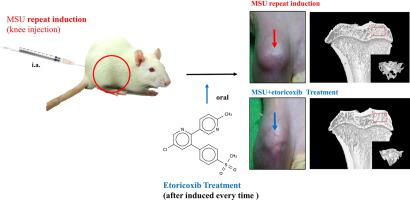Journal of Advanced Research ( IF 11.4 ) Pub Date : 2020-02-29 , DOI: 10.1016/j.jare.2020.02.014 Yen-You Lin , Yen-Hsuan Jean , Sung-Chun Lin , Chien-Wei Feng , Hsiao-Mei Kuo , Yu-Cheng Lai , Tsu-Jen Kuo , Nan-Fu Chen , Hsin-Pai Lee , Zhi-Hong Wen

|
Deposition of monosodium urate (MSU) crystals in the joint or synovium is the major factor in Gouty arthritis (GA). The clinical features of chronic and recurrent GA include pain and the subsequent development of chronic tophaceous GA with multiple tophi deposits accompanied by osteolysis. The majority of previous animal studies have focused on MSU-induced acute GA without making observations regarding osteolysis. In the study, intra-articular injections of MSU into the knee (2 times/week for 10 weeks) was used to induce chronic and recurrent attacks of GA that in turn induced progressive osteolysis. Moreover, we also evaluated whether the clinical, nonsteroidal anti-inflammatory drug (NSAID) etoricoxib attenuated the osteoclastogenesis of progressive osteolysis. The knee morphometry and the expression of osteoclastogenesis-related proteins (cathepsin K and matrix metalloproteinase-9 and -13) in the knee were examined by micro-CT and immunohistochemistry, respectively. Results showed that oral etoricoxib not only significantly attenuated the nociceptive behaviors of the rats but that it also inhibited the expression of osteoclastogenesis-related proteins in their knee joints in chronic and recurrent attacks of GA. Our findings thus suggest that NSAIDs not only inhibit nociception but also prevent the progression of osteolysis in chronic and repeated attacks of GA.
中文翻译:

依托考昔可预防大鼠反复关节内尿酸钠诱导的痛风性关节炎的骨溶解进展
尿酸钠 (MSU) 晶体在关节或滑膜中的沉积是痛风性关节炎 (GA) 的主要因素。慢性和复发性 GA 的临床特征包括疼痛和随后发展为慢性痛风石性 GA,伴有多处痛风石沉积并伴有骨质溶解。之前的大多数动物研究都集中在密歇根州立大学诱发的急性 GA 上,而没有对骨溶解进行观察。在这项研究中,通过向膝关节内注射 MSU(每周 2 次,持续 10 周)来诱导 GA 的慢性和复发性发作,进而诱导进行性骨溶解。此外,我们还评估了临床非甾体类抗炎药(NSAID)依托考昔是否会减弱进行性骨质溶解的破骨细胞生成。分别通过显微CT和免疫组织化学检查膝关节形态测量和破骨细胞生成相关蛋白(组织蛋白酶K和基质金属蛋白酶-9和-13)的表达。结果表明,口服依托考昔不仅能显着减弱大鼠的伤害感受行为,而且还能抑制慢性和反复发作的 GA 膝关节中破骨细胞生成相关蛋白的表达。因此,我们的研究结果表明,NSAID 不仅可以抑制伤害感受,还可以防止 GA 慢性和反复发作时骨质溶解的进展。











































 京公网安备 11010802027423号
京公网安备 11010802027423号